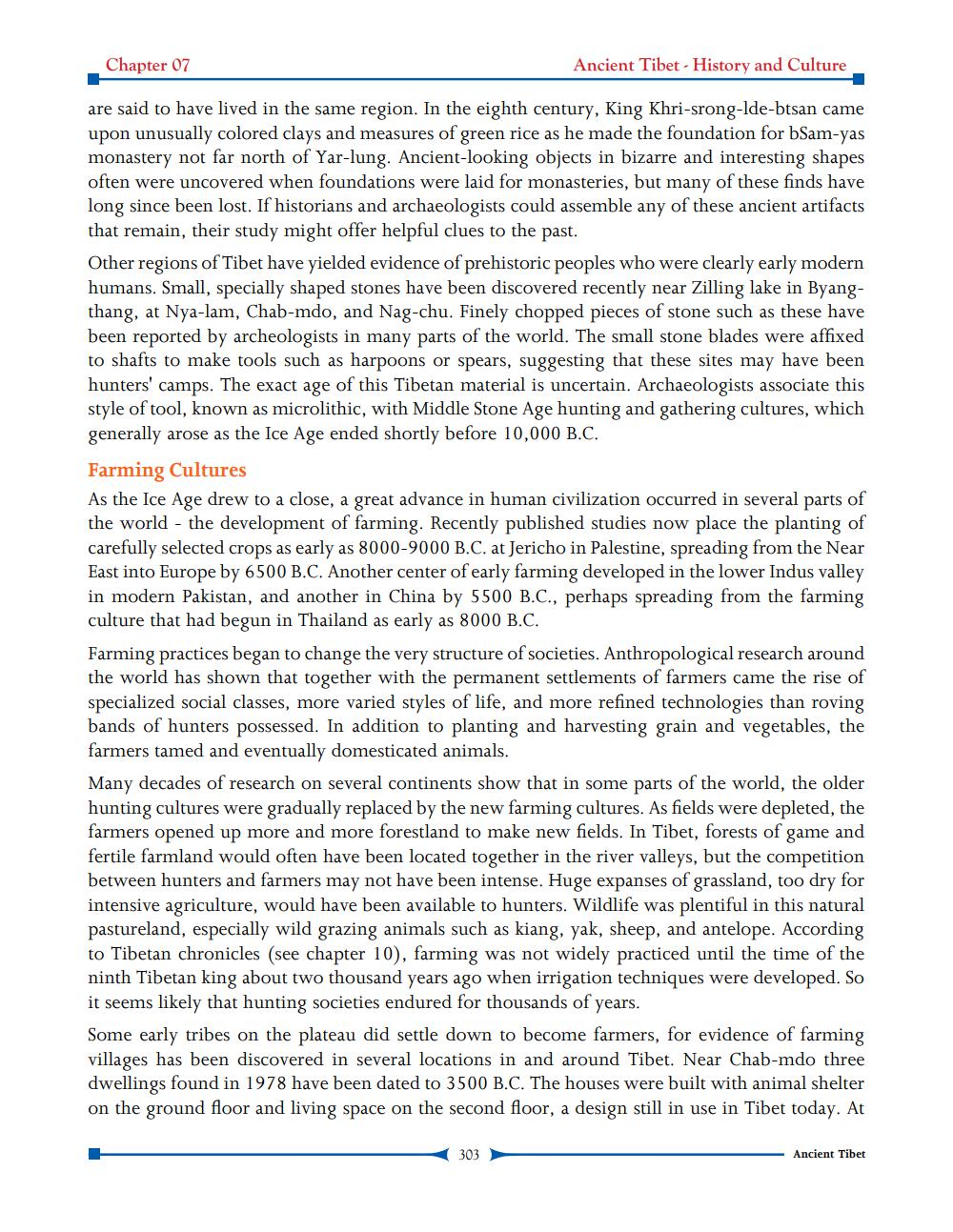________________
Chapter 07
Ancient Tibet - History and Culture
are said to have lived in the same region. In the eighth century, King Khri-srong-lde-btsan came upon unusually colored clays and measures of green rice as he made the foundation for bSam-yas monastery not far north of Yar-lung. Ancient-looking objects in bizarre and interesting shapes often were uncovered when foundations were laid for monasteries, but many of these finds have long since been lost. If historians and archaeologists could assemble any of these ancient artifacts that remain, their study might offer helpful clues to the past.
Other regions of Tibet have yielded evidence of prehistoric peoples who were clearly early modern humans. Small, specially shaped stones have been discovered recently near Zilling lake in Byangthang, at Nya-lam, Chab-mdo, and Nag-chu. Finely chopped pieces of stone such as these have been reported by archeologists in many parts of the world. The small stone blades were affixed to shafts to make tools such as harpoons or spears, suggesting that these sites may have been hunters' camps. The exact age of this Tibetan material is uncertain. Archaeologists associate this style of tool, known as microlithic, with Middle Stone Age hunting and gathering cultures, which generally arose as the Ice Age ended shortly before 10,000 B.C.
Farming Cultures
As the Ice Age drew to a close, a great advance in human civilization occurred in several parts of the world - the development of farming. Recently published studies now place the planting of carefully selected crops as early as 8000-9000 B.C. at Jericho in Palestine, spreading from the Near East into Europe by 6500 B.C. Another center of early farming developed in the lower Indus valley in modern Pakistan, and another in China by 5500 B.C., perhaps spreading from the farming culture that had begun in Thailand as early as 8000 B.C.
Farming practices began to change the very structure of societies. Anthropological research around the world has shown that together with the permanent settlements of farmers came the rise of specialized social classes, more varied styles of life, and more refined technologies than roving bands of hunters possessed. In addition to planting and harvesting grain and vegetables, the farmers tamed and eventually domesticated animals.
Many decades of research on several continents show that in some parts of the world, the older hunting cultures were gradually replaced by the new farming cultures. As fields were depleted, the farmers opened up more and more forestland to make new fields. In Tibet, forests of game and fertile farmland would often have been located together in the river valleys, but the competition between hunters and farmers may not have been intense. Huge expanses of grassland, too dry for intensive agriculture, would have been available to hunters. Wildlife was plentiful in this natural pastureland, especially wild grazing animals such as kiang, yak, sheep, and antelope. According to Tibetan chronicles (see chapter 10), farming was not widely practiced until the time of the ninth Tibetan king about two thousand years ago when irrigation techniques were developed. So it seems likely that hunting societies endured for thousands of years.
Some early tribes on the plateau did settle down to become farmers, for evidence of farming villages has been discovered in several locations in and around Tibet. Near Chab-mdo three dwellings found in 1978 have been dated to 3500 B.C. The houses were built with animal shelter on the ground floor and living space on the second floor, a design still in use in Tibet today. At
303
Ancient Tibet




